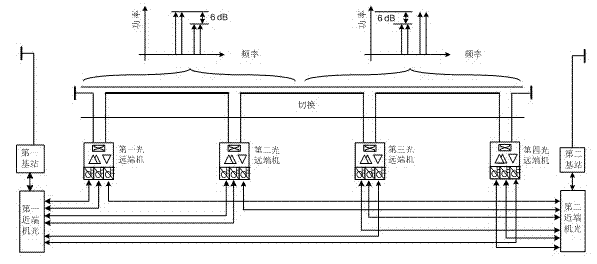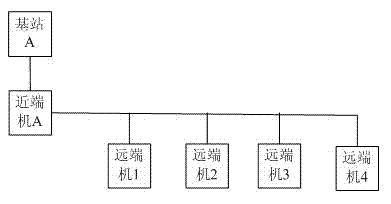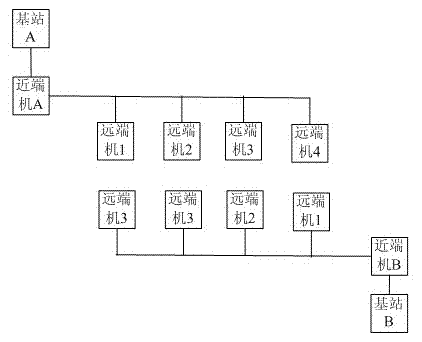Optical fiber network system
An optical fiber network and optical fiber technology, which is applied in the field of optical fiber network systems, can solve the problems of reduced level coverage, low reliability, and multiple maintenance of equipment, and achieves stable signal, high stability and reliability, and fast network construction. Effect
- Summary
- Abstract
- Description
- Claims
- Application Information
AI Technical Summary
Problems solved by technology
Method used
Image
Examples
Embodiment 1
[0046] Such as figure 1 As shown, this example provides an optical fiber network system, including:
[0047] the first base station;
[0048] The first optical near-end unit is connected to the first base station;
[0049] second base station;
[0050] a second optical near-end unit connected to the second base station;
[0051] The first optical remote unit exchanges optical information with the first optical near-end unit through two optical fibers, and exchanges optical information with the second optical near-end unit through one optical fiber;
[0052] The second optical remote unit exchanges optical information with the first optical near-end unit through two optical fibers, exchanges optical information with the second optical near-end unit through one optical fiber, and exchanges optical information with the first optical remote unit connect;
[0053] The third optical remote machine exchanges optical information with the second optical near-end machine through tw...
Embodiment 2
[0062] The difference from Embodiment 1 is that the first optical remote unit, the second optical remote unit, the third optical remote unit and the fourth optical remote unit in this example are connected to the first optical remote unit in a star network. One optical near-end machine and the second optical near-end machine.
[0063] This example further adopts the above-mentioned technical features, and its advantage is that it can realize a highly reliable optical fiber network system, increase the coverage area, and ensure that the working processes of the first optical near-end machine and the second optical near-end machine are mutually active and standby. interfered, on this basis, the first optical remote unit, the second optical remote unit, the third optical remote unit and the fourth optical remote unit are connected to the first optical remote unit in a star network The near-end machine and the second optical near-end machine make the networking mode more flexible,...
Embodiment 3
[0065] Different from Embodiment 1, leaky cables are used to connect the first optical remote unit, the second optical remote unit, the third optical remote unit and the fourth optical remote unit in this example.
[0066] This example further adopts the above-mentioned technical features, and its advantage is that it can realize a highly reliable optical fiber network system, increase the coverage area, and ensure that the working processes of the first optical near-end machine and the second optical near-end machine are mutually active and standby. Interference, on this basis, the first optical remote unit, the second optical remote unit, the third optical remote unit and the fourth optical remote unit are connected by leaky cables, especially in rail communication systems In the case of a long and narrow strip, the leaky cable connection is used as a coverage antenna, which is especially suitable for coverage in tunnel engineering environments, with stable signals and high r...
PUM
 Login to View More
Login to View More Abstract
Description
Claims
Application Information
 Login to View More
Login to View More - R&D
- Intellectual Property
- Life Sciences
- Materials
- Tech Scout
- Unparalleled Data Quality
- Higher Quality Content
- 60% Fewer Hallucinations
Browse by: Latest US Patents, China's latest patents, Technical Efficacy Thesaurus, Application Domain, Technology Topic, Popular Technical Reports.
© 2025 PatSnap. All rights reserved.Legal|Privacy policy|Modern Slavery Act Transparency Statement|Sitemap|About US| Contact US: help@patsnap.com



